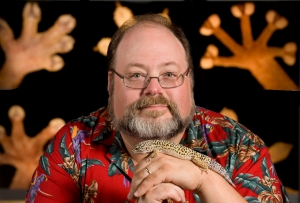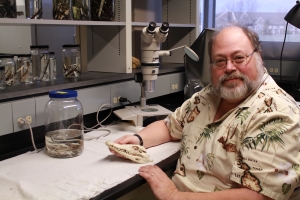Villanova Biology Professor Dr. Aaron Bauer Discusses his Life’s Work Studying, and Discovering, Geckos and Other Reptiles

The world’s most popular gecko may be the one starring in countless Geico television commercials. Although that gecko was not the discovery of Villanova Biology professor Aaron Bauer, PhD, it may be one of the few he hasn’t described. You see, Dr. Bauer—who also serves as the Gerald M. Lemole Endowed Chair in Integrative Biology at Villanova—has described more new species of reptiles than any other living scientist, including over seven percent of the more than 1,800 living geckos.
To learn more about Dr. Bauer’s research, how he got interested in this field and what’s next for him, we asked him a series of questions.
Q: How did you first become interested in studying reptiles, especially geckos?
Aaron Bauer (AB): I grew up on Long Island, N.Y., where my grandfather was the caretaker of a large private estate. As a child I spent my days looking for and catching amphibians and reptiles in our ponds and meadows. I also took many trips to the American Museum of Natural History and read everything I could about reptiles. By the time I was five years old, I knew I wanted to be a herpetologist (the study of amphibians and reptiles).
I think I gravitated towards lizards because they weren’t native to Long Island, whereas there were plenty of turtles and snakes. Geckos intrigued me because they were more exotic – almost no native species in the U.S. and none closer to me than south Florida. I also became interested in anatomy and recognized that geckos exhibited many unique structures, like their toepads, and that basically sealed my fate.
Q: What is it that fascinates you about these creatures?
AB: Geckos are ideal animals for asking any number of evolutionary questions. The group is at least 150 million years old and there are almost 1,800 living species. With that age and diversity one can ask questions about everything from the physical relationships of ancient landmasses to one another to current thermal responses to climate change. Geckos have many unique features. Many can climb using intermolecular forces, they are the only mostly nocturnal group of lizards, they are the most vocal of all reptiles, some give live birth, some are all-female species. The list goes on and on. As an evolutionary biologist, anatomist and systematist they offer almost endless opportunities for study.

Q: What is the goal of your research?
AB: I am interested in pattern of biotic diversity. What is the genealogical pattern of life (phylogenetics), what is the developmental pattern of life (ontogeny), what is the spatial pattern of life (biogeography), and what is the temporal pattern of life (paleontology)? My ultimate goal is to use geckos and other reptiles to answer these questions about the nature of life on earth. This includes everything from discovery (going to the field and discovering new species) to the application of molecular and morphological data to find the position of each species in the tree of life, to analytical approaches to understand how earth history has influenced the patterns and rates of evolution.
Q: You participate in a group called the Atlas of Life. Could you share some information about your work and role there?
AB: I am part of a consortium of herpetologists who have collectively developed distributional data for all 10,000-plus reptile species around the world. The sum of these data, the Atlas of Life, can be used to ask many questions in the broad field of macroecology. For example, how does the diversity of reptiles vary across the Earth? Or is reproductive output greater at some latitudes than others?
In one of our most comprehensive papers, we examined reptile hotspots around the world and found that lizards do things different from snakes, turtles and indeed all other terrestrial vertebrates. While most groups reach their greatest diversity in the wet tropics of the world, lizards do best in arid environments. My contribution to the project was to provide data for all reptiles from parts of the world where I conduct my research — southern and central Africa, India and South Asia and islands of the Pacific, and to contribute to the synthesis of the data globally.
Q: What future research projects do you have planned?
AB: Right now, I am working on several book and monograph projects. One is a book on the biology of geckos in light of their evolutionary relationships. Another is a book on the reptiles and amphibians of Namibia, in southwest Africa. I am also updating my earlier book on the herpetofauna of New Caledonia, a French territory in the South Pacific. I am also working on a large integrative project on vision in geckos, studies of 100 million year old lizards in amber, and a historical project that is a translation and annotation of an important set of books, originally in Latin, from the early period of herpetological investigation at the beginning of the 19th century.
To learn more about Bauer, view his profile on the Media Expert Center.
